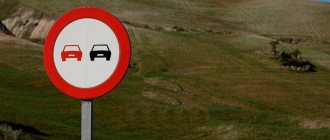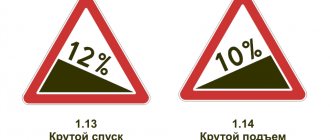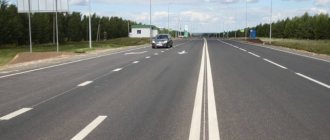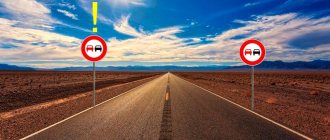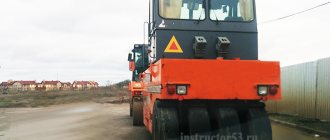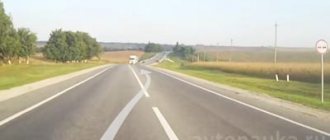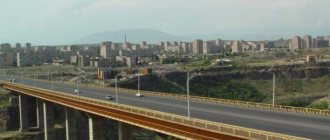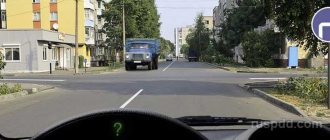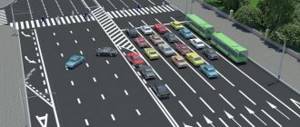The issue of overtaking is always relevant among car enthusiasts. And this is quite understandable - performing this maneuver in the wrong place or with other traffic violations may result in deprivation of your license. Many drivers would not mind avoiding such a turn of events. This is why it is so important to have information regarding overtaking rules and to find out whether double overtaking is allowed under the rules.
The rules do not prohibit overtaking several vehicles, but under certain conditions. The article discusses the rules for overtaking several cars and provides a list of situations when overtaking a car is prohibited. In addition, you can familiarize yourself with the fines for overtaking and learn how not to lose your license.
Rules for overtaking two or more vehicles in a row
The concept of overtaking is given in the traffic rules - paragraph 1.2.
This is the name for a maneuver in which a car is ahead of one or more vehicles, entering the oncoming lane, and then returns to its original lane.
Therefore, the answer to the question of whether double overtaking is allowed is an unequivocal yes, but under certain conditions.
Detailed instructions regarding performing such a maneuver are given in Chapter 11 of the Rules.
Overtaking one or more vehicles is carried out in compliance with certain rules.
Before you start overtaking vehicles, you should make sure that there are no oncoming cars in the oncoming lane or that they are at a distance sufficient to complete the maneuver. In this case, there will be no danger of the vehicle moving on the roadway or interference with those participating in road traffic (11.1).
The requirement is appropriate, since any movement in the oncoming lane is a big risk for both the motorist and other participants.
If suddenly the driver’s actions lead to an accident, then he will be considered guilty.
Unless the driver of the overtaken car violated the Rules and tried to prevent overtaking - he increased the speed during the maneuver or performed other actions (11.3).
Overtaking should only be avoided under certain circumstances (11.2):
- While making a detour (overtaking) by a car in front.
- Before performing the maneuver, a left turn signal is given to the vehicle moving ahead.
- The car behind began to overtake the vehicle.
- When overtaking, an obstacle will be created for the overtaken vehicle and a danger to traffic. In this case, it is impossible to return to the lane from which the vehicle left without this risk.
Thus, the prohibition applies when maneuvering in front of or behind vehicles.
It is also prohibited to overtake when the vehicle speed is insufficient - when there is a risk of being unable to complete the maneuver for this reason.
That is, if the driver initially sees that he is having difficulty catching up with the vehicle ahead in his car, he cannot overtake.
Prohibitions also apply in certain areas (11.4):
- in the area of intersections, regardless of whether they are regulated or not. But if the car is moving on a secondary road;
- on the zebra crossing;
- at railway crossings and 100 meters from them;
- when completing a climb, at a dangerous turn and other areas with poor visibility.
Additionally, Art. 9.11 Regulations
It is unacceptable to drive in oncoming traffic on a two-way road if this lane is separated:
- tracks for trams;
- dividing strip;
- a certain marking (1.1, 1.3 or 1.11), if the intermittent one is placed on the left side.
The clause prohibits a vehicle from being on the oncoming lane if it is separated by a solid lane (single or double).
That is, if the driver sees in advance the end of the intermittent markings and the approaching solid markings, there is no need to overtake.
Overtaking rules
The pictures of double overtaking in a driving textbook will show any driver how to perform the maneuver correctly.
Knowing paragraph 11 of the traffic rules, before overtaking you must be extremely sure that there is no traffic in the oncoming lane. The rules do not include such a thing as double overtaking. But they stipulate that this type of maneuvering is not carried out if:
- the car in front did not turn on the left turn signal and began to drive out to overtake the car in front of it;
- the car moving behind him began to overtake;
- it will be impossible to complete the changeover without interfering with the overtaken vehicle.
You must ensure that your maneuvers do not create obstacles for other road users.
Responsibility for violating the rules of overtaking
All violations committed when overtaking one, two or more vehicles are qualified under Article 12.15 of the Code of Administrative Offences.
The article does not specifically indicate penalties for illegal overtaking. But you need to remember that such maneuvering is associated with the need to enter the oncoming lane.
| Description of the violation | Qualification | Type and scope of responsibility |
| The driver violates traffic rules and drives into oncoming traffic or onto the tracks for trams moving in the opposite direction. | Part 4 | Fine 5000 rub. or deprivation of the ability to drive a vehicle for a period of 4 to 6 months. |
| Committing the specified violation again. | Part 5 | The driver may be deprived of the ability to drive a car for a period of up to a year. The punishment is milder if the violation is recorded on camera - a fine of 5,000 rubles. |
The penalty for double overtaking or regular overtaking is the same.
Rights will be deprived on the basis of Part 4 only when entering oncoming traffic in places where overtaking vehicles is prohibited.
For example, in the case of crossing solid markings while overtaking, when starting a maneuver on a bridge, or in an area with a dangerous turn.
Completing overtaking while crossing solid markings will also be regarded as an offence.
Crossing a double solid line
In all other cases, for crossing a solid marking line, minimum liability is provided in the form of a warning or a fine of 500 rubles under Part 1 of Article 12.16 of the Code of Administrative Offenses of the Russian Federation.
1. Failure to comply with the requirements prescribed by road signs or markings of the roadway, with the exception of cases provided for in parts 2 - 7 of this article and other articles of this chapter, shall entail a warning or the imposition of an administrative fine in the amount of five hundred rubles .
Many drivers do not even notice such violations, because today there is a very low probability that they will be fined for them.
In the parking lot.
Despite the fact that crossing a double solid line in some cases does not entail serious punishment, you should still avoid doing it if possible. First of all, this is due to the safety of road users. It must be remembered that driving into the oncoming lane is a risk of a traffic accident, and therefore a risk of harm to life, health and property. Therefore, you always need to think about other people and strictly follow the requirements of the Road Traffic Rules.
A solid line is located in different places on the road and comes in the form of one (single) or two (double) white stripes.
A single continuous road (1.2) located along the edge of the road is allowed to be crossed if there is no sign 3.27, which prohibits the presence of a car on the side of the road. But crossing single continuous lines (1.1) under a strict ban is an administrative offense.
In practice, arrogant drivers deliberately do not pay attention to the prohibitory markings dividing the highway in half. The types of violations associated with ignoring a continuous line are divided depending on what goal the driver is pursuing and where he ends up as a result of the movement.
According to statistics, the main goal pursued by drivers driving beyond a solid line is to overtake cars in traffic. At the same time, for a short period of time, the offender’s vehicle ends up in the oncoming lane.
Legislators have established sections of roads on which overtaking is never permitted under any circumstances.
The ban has been established in areas:
- overpasses, bridges, overpasses, tunnels;
- at intersections, unless overtaking occurs on the main road in the absence of a traffic light;
- at pedestrian crossings;
- railway crossings, starting 100 m before them;
- poorly visible sections of roads.
Usually in these places not only a solid line is drawn, but also a corresponding prohibitory sign is placed.
If there is no road sign, it is necessary to comply with the markings, otherwise, if the violator is stopped by an inspector, he will be held liable under Part 4 of Art. 12.15 Code of Administrative Offenses of the Russian Federation cannot be avoided.
Once you see a non-broken marking line, you can forget about overtaking. What can you say about the “Overtaking is prohibited” sign. Such a sign provides for an exception and allows overtaking of slow-moving vehicles if it is located where there is no continuous line.
If there is a continuous and simultaneously installed sign prohibiting overtaking, the exception does not apply. It follows from this that if there is a sign 3.20 and a double solid one, it is prohibited to go around the slow-moving vehicle.
Before you decide to overtake, you need to make sure that there are no prohibitions listed above, and that the vehicle ahead is really a slow-moving vehicle that has distinctive features.
Characteristics of low-speed vehicles:
- The maximum speed set by the manufacturer is 30 km/h. These include agricultural and asphalt paving equipment.
- The presence of a special sign - a red triangle with a yellow or red frame.
At the same time, the Supreme Court of Russia, in a recent resolution No. 20 dated June 25, 2019, clarified that the absence of a special sign on a slow-moving vehicle cannot be attributed to the fault of the overtaking driver. In this case, liability under Part 4 of Art. 12.15 of the Code of Administrative Offenses of the Russian Federation, and even more so the deprivation of a driver’s license is excluded.
Since it is almost impossible to know in advance the maximum acceleration speed of vehicles, it is better not to risk your rights.
When turning left, the car inevitably ends up on oncoming traffic. Understanding this and realizing that driving through a continuous road is not only a fine (Part 4 of Article 12.15 of the Code of Administrative Offenses of the Russian Federation), drivers are mentally preparing to part with their licenses.
Meanwhile, legislators do not equate turning left with driving into oncoming traffic. A separate article is provided for this violation, namely Part 2 of Art. 12.16 Code of Administrative Offenses of the Russian Federation. Punishment is limited to a monetary sanction in the amount of 1 – 1.5 thousand rubles.
The degree of public danger when turning left is less than when overtaking by passing a continuous road. After all, the driver has no goal of driving against the flow of cars.
The main thing is not where the car ends up immediately after crossing a continuous road, but in which direction it is heading. Therefore, when turning left, such a severe punishment as deprivation of rights is not provided.
When driving through a solid line, controversial issues often arise, mainly related to the condition of the road surface and the abuses of the traffic police inspector.
Thus, there are often markings that cannot be seen due to weather or road conditions: they are covered with snow, worn out, washed out. And objective reasons - the absence of basic and duplicate signs of special instructions (5.15.6, 5.15.7).
In such cases, it is impossible to understand which line separates the lanes and where the oncoming traffic begins. To protect yourself from unfounded accusations, you need to take photographs of the road surface and copy material from the DVR.
Another example would be a situation where, according to the rules, it is impossible to avoid an obstacle on the roadway. The driver is forced to violate the markings.
To prevent adverse consequences in the form of administrative punishment, you will have to prove that there was an extreme need. After all, there was no other way out at that time.
It is worth noting that there are significantly fewer inadequate traffic police officers; they treat such situations with understanding and do not issue a fine.
After being stopped by an inspector for a traffic violation, pay close attention to the compilation of the material.
The protocol is the main document that guides the court when considering cases of traffic violations. And if there are no notes on objections regarding the fact established by the inspector, the court will not pay any attention to them in the future.
In order to correctly build a line of conduct, you need to write in the protocol about the need to have a defense attorney and for now refuse to testify on the basis of Art. 51 of the Constitution of the Russian Federation.
As a general rule, materials are considered at the place where the offense was committed. But it often happens that the inspector stops someone far from the violator’s region of residence. In this case, you can apply for consideration of the case at your place of residence.
If there were passengers in the car at the time of the stop, it is advisable to record them in the protocol as witnesses.
To defend your position on innocence and the absence of a violation, you need to work out a line of defense.
At a minimum, a petition is being prepared to request the dislocation of traffic on the disputed section of the route. At most, a visit to the place where the protocol is drawn up is carried out for photo and video recording of the absence of signs and marking. Everything is formalized by deed.
A good reason for the court will be non-compliance with the requirements for installing signs and markings on the road.
Typical violations:
- The sign contradicts the applied markings if it was installed temporarily and they forgot to remove it.
- Unreadable, difficult to view signs and markings.
- Conflicting road signs.
- Installation not in accordance with GOST.
If there are contradictions between the dislocation and the real state of affairs, it is worth saying that the driver was not oriented to the driving mode, and therefore could not react to the situation properly.
By reasonably pointing out violations and supporting them with evidence, you will be able to avoid unfair punishment.
After all, I would have done it anyway, even if I hit the brakes and changed lanes back, I would still have crossed a continuous road. And is there a GOST or any standards for how far markings 1.6 should be applied before markings 1.1 or 1.11 begin?
The penalty for crossing a solid or double solid line marking covers almost the entire range of liability for traffic violations and can range from a warning to deprivation of a driver’s license for 1 year, depending on the circumstances of the violation. We will consider these circumstances on their merits, so that in the event of crossing a continuous marking you know the correct classification of the offense.
Overtaking traffic jam through intermittent
Those caught in a traffic jam cannot move outside their lane, overtaking cars ahead. With intermittent markings, the driver can only turn the car around and go back.
First of all, this is due to the ban on overtaking cars without the opportunity to return to the same lane. There is a significant risk that, having passed more than a hundred cars, the driver will not be able to immediately occupy his lane and will end up in oncoming traffic, and this is a guaranteed accident.
Secondly, with paragraph 11.4, which prohibits overtaking a car if visibility on the road is difficult. Visibility may be limited by obstacles generated along the vehicle's path, at least 100 meters away from it. We are talking not only about construction work, but also about parked vehicles or cars stuck in traffic jams.
Violation of the rules of overtaking in this case will entail punishment determined by Part 4 of Art. 12.15 Code of Administrative Offences.
This rule does not apply only to special services vehicles (ambulance, police, fire department, etc.) if sound signals are sounded and flashing lights are turned on.
Overtaking an organized convoy accompanied by traffic police
The vehicle convoy may additionally be accompanied by traffic police, but only in some cases:
- When a convoy is organized to transport high officials.
- Large groups of children are transported.
- The transported cargo is classified into a certain category (dangerous, oversized, heavy, large).
- Accompanied by equipment for use in eliminating emergencies or disasters of a natural or other nature.
The rules prohibit overtaking an organized convoy of cars if it meets the following criteria:
- Consists of at least three vehicles.
- Cars are accompanied by traffic police (flash lights are on, there is a distinctive color scheme).
- Vehicles move with their low headlights and running lights turned on.
- Cars in a column move in one lane.
- The accompanying vehicle must also sound its horn.
It is allowed to overtake several cars in a convoy at the same time, if the participants do not give appropriate signals and there is no accompanying vehicle.
It is necessary to take into account that ahead of the column is allowed, since in this case there is no need to drive into oncoming traffic.
In practice, organized columns are sometimes accompanied by special vehicles without sound signals. Overtaking in this case will be considered a violation. Punishment will follow for driving into oncoming traffic in violation.
It is also not recommended to overtake military vehicles moving in an organized convoy. Such transport is always accompanied by the Military Traffic Inspectorate.
Types of violations
There is another maneuver, which is also sometimes called a double maneuver - when two or more cars find themselves in the oncoming traffic and drive like a train.
The driver who started overtaking first will be innocent of violating the rules, but this can only be proven if there is a DVR or camera. Sometimes a traffic police inspector present nearby also notices who left first.
The rules prohibit performing a double overtaking maneuver (11.2 Traffic Regulations) if the driver ahead or behind pulls into oncoming traffic to overtake.
It is difficult to prove the absence of a violation in overtaking situations: even if a traffic police officer saw what was happening, he might not have noticed who drove into the oncoming lane first; accordingly, both drivers or all drivers taking part in the maneuver will be at fault.
